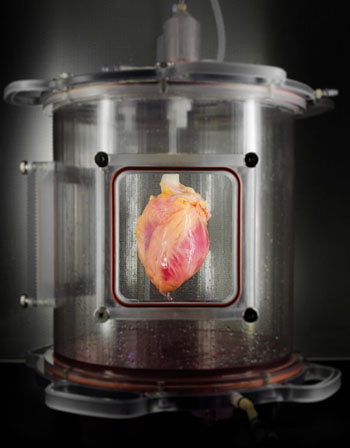Stripped Heart Matrix Supports Growth of Rejection-Free Replacement Organ
By LabMedica International staff writers
Posted on 21 Mar 2016
A team of bioengineers used a decellularized heart matrix as scaffolding to rebuild the organ for transplantation without immune markers that would prime the organ for rejection.Posted on 21 Mar 2016
Investigators at Massachusetts General Hospital (Boston, USA) had demonstrated the feasibility of this approach using rat hearts. In the current study, they sought to upscale the method to accommodate human hearts.

Image: A partially recellularized human whole-heart cardiac scaffold, reseeded with human cardiomyocytes derived from induced pluripotent stem cells, being cultured in a bioreactor that delivers a nutrient solution and replicates some of the environmental conditions around a living heart (Photo courtesy of Dr. Bernhard Jank, Ott Laboratory, Massachusetts General Hospital).
The procedure involved stripping cellular components from donor hearts that had been found to be unsuitable for transplantation. The remaining extracellular matrix scaffold, which did not contain any immune markers, could then be seeded with organ-appropriate cell types. To prevent rejection by the potential recipient of the organ, seed cardiomyocytes were derived from induced pluripotent stem cells (iPSCs) that had been generated from the patient's skin cells.
The investigators repopulated the native human cardiac matrix with stem-cell derived cardiomyocytes and generated tissues of increasing three-dimensional complexity. They maintained such cardiac tissue constructs in culture for 120 days to demonstrate definitive sarcomeric structure, cell and matrix deformation, contractile force, and electrical conduction. Under culture conditions that mimicked those within the human body, the seeded constructs developed force-generating myocardial tissue and showed electrical conductivity, left ventricular pressure development, and metabolic function.
Summarizing their results in the January 8, 2016, issue of the journal Circulation Research, the investigators stated that native cardiac extracellular matrix scaffolds maintained matrix components and structure to support the seeding and engraftment of human iPSCs–derived cardiomyocytes and enabled the bioengineering of functional human myocardial-like tissue of multiple complexities.
"Generating functional cardiac tissue involves meeting several challenges," said first author Dr. Jacques Guyette, a postdoctoral research fellow at Massachusetts General Hospital. "These include providing a structural scaffold that is able to support cardiac function, a supply of specialized cardiac cells, and a supportive environment in which cells can repopulate the scaffold to form mature tissue capable of handling complex cardiac functions."
"Regenerating a whole heart is most certainly a long-term goal that is several years away, so we are currently working on engineering a functional myocardial patch that could replace cardiac tissue damaged due a heart attack or heart failure," said Dr. Guyette. "Among the next steps that we are pursuing are improving methods to generate even more cardiac cells—recellularizing a whole heart would take tens of billions—optimizing bioreactor-based culture techniques to improve the maturation and function of engineered cardiac tissue, and electronically integrating regenerated tissue to function within the recipient's heart."
Related Links:
Massachusetts General Hospital




 assay.jpg)








